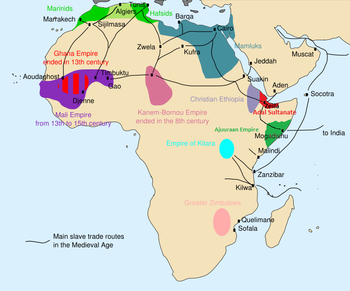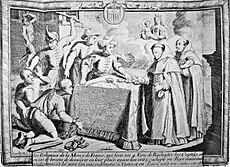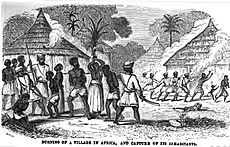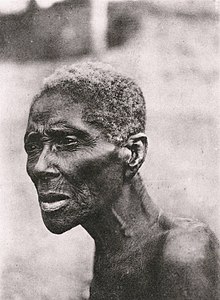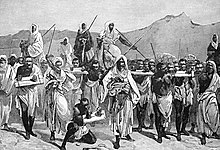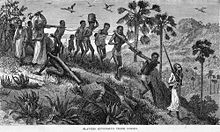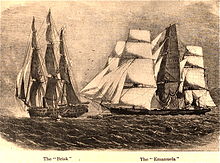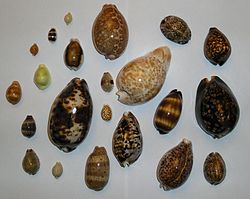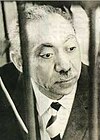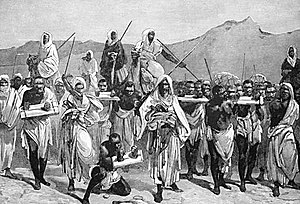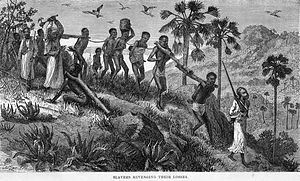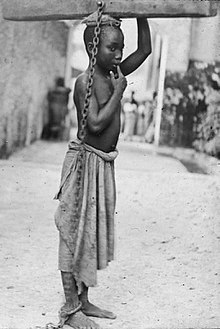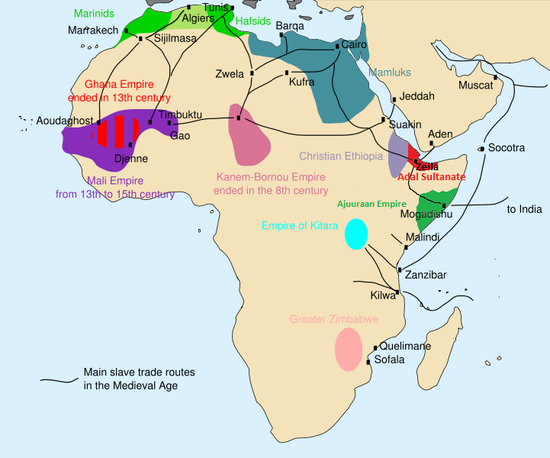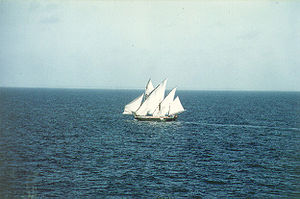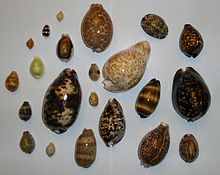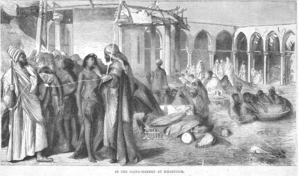The main slave routes in medieval Africa.
Slavery has historically been widespread in Africa, and still continues today in some countries.
Systems of servitude and slavery were common in parts of Africa, as they were in much of the ancient world. In many African societies where slavery was prevalent, the enslaved people were not treated as chattel slaves and were given certain rights in a system similar to indentured servitude elsewhere in the world. When the Arab slave trade and Atlantic slave trade began, many of the local slave systems began supplying captives for slave markets outside Africa.
Slavery in historical Africa was practiced in many different forms: Debt slavery,
enslavement of war captives, military slavery,slavery for prostitution
and criminal slavery were all practiced in various parts of Africa.
Slavery for domestic and court purposes was widespread throughout
Africa.
Plantation slavery also occurred primarily on the eastern coast
of Africa and in parts of West Africa. The importance of domestic
plantation slavery increased during the 19th century due to the
abolition of the Atlantic slave trade. Many African states dependent on
the international slave trade reoriented their economies towards
legitimate commerce worked by slave labor.
Forms of slavery
Multiple
forms of slavery and servitude have existed throughout African history
and were shaped by indigenous practices of slavery as well as the Roman institution of slavery (and the later Christian views on slavery), the Islamic institutions of slavery via the Arab slave trade, and eventually the Atlantic slave trade.
Slavery was a part of the economic structure of African societies for many centuries, although the extent varied.
Ibn Battuta,
who visited the ancient kingdom of Mali in the mid-14th century,
recounts that the local inhabitants vied with each other in the number
of slaves and servants they had, and was himself given a slave boy as a
"hospitality gift."
In sub-Saharan Africa, the slave relationships were often complex, with
rights and freedoms given to individuals held in slavery and
restrictions on sale and treatment by their masters.
Many communities had hierarchies between different types of slaves: for
example, differentiating between those who had been born into slavery
and those who had been captured through war.
"The slaves in Africa, I suppose, are nearly in the proportion of three to one to the freemen. They claim no reward for their services except food and clothing, and are treated with kindness or severity, according to the good or bad disposition of their masters. Custom, however, has established certain rules with regard to the treatment of slaves, which it is thought dishonourable to violate. Thus the domestic slaves, or such as are born in a man’s own house, are treated with more lenity than those which are purchased with money. ... But these restrictions on the power of the master extend not to the care of prisoners taken in war, nor to that of slaves purchased with money. All these unfortunate beings are considered as strangers and foreigners, who have no right to the protection of the law, and may be treated with severity, or sold to a stranger, according to the pleasure of their owners." Travels in the Interior of Africa, Mungo Park, Travels in the Interior of Africa v. II, Chapter XXII – War and Slavery.
The forms of slavery in Africa were closely related to kinship
structures. In many African communities, where land could not be owned,
enslavement of individuals was used as a means to increase the
influence a person had and expand connections.
This made slaves a permanent part of a master's lineage and the
children of slaves could become closely connected with the larger family
ties.
Children of slaves born into families could be integrated into the
master's kinship group and rise to prominent positions within society,
even to the level of chief in some instances.
However, stigma often remained attached and there could be strict
separations between slave members of a kinship group and those related
to the master.
Chattel slavery
Chattel slavery
is a specific servitude relationship where the slave is treated as the
property of the owner. As such, the owner is free to sell, trade, or
treat the slave as he would other pieces of property and the children of
the slave often are retained as the property of the master.
There is evidence of long histories of chattel slavery in the Nile
river valley and Northern Africa, but evidence is incomplete about the
extent and practices of chattel slavery throughout much of the rest of
the continent prior to written records by Arab or European traders.
Domestic service
Many
slave relationships in Africa revolved around domestic slavery, where
slaves would work primarily in the house of the master but retain some
freedoms. Domestic slaves could be considered part of the master's
household and would not be sold to others without extreme cause. The
slaves could own the profits from their labour (whether in land or in
products), and could marry and pass the land on to their children in
many cases.
Pawnship
Pawnship, or debt bondage slavery, involves the use of people as collateral to secure the repayment of debt. Slave labor is performed by the debtor, or a relative
of the debtor (usually a child). Pawnship was a common form of
collateral in West Africa. It involved the pledge of a person or a
member of that person's family, to serve another person providing credit.
Pawnship was related to, yet distinct from, slavery in most
conceptualizations, because the arrangement could include limited,
specific terms of service to be provided and because kinship ties would
protect the person from being sold into slavery. Pawnship was a common
practice throughout West Africa prior to European contact, including
amongst the Akan people, the Ewe people, the Ga people, the Yoruba people, and the Edo people (in modified forms, it also existed amongst the Efik people, the Igbo people, the Ijaw people, and the Fon people).
Military slavery
Slaves for sacrifice at the Annual Customs of Dahomey – from The history of Dahomy, an inland Kingdom of Africa, 1793.
Military slavery involved the acquisition and training of conscripted
military units which would retain the identity of military slaves even
after their service. Slave soldier groups would be run by a Patron,
who could be the head of a government or an independent warlord, and
who would send his troops out for money and his own political interests.
This was most significant in the Nile valley (primarily in Sudan
and Uganda), with slave military units organized by various Islamic
authorities, and with the war chiefs of Western Africa.
The military units in Sudan were formed in the 1800s through
large-scale military raiding in the area which is currently the
countries of Sudan and South Sudan.
Moreover, a considerable number of the men born between 1800 and 1849 in West African regions (today Ghana and Burkina Faso) and abducted as slaves to serve in the army in Dutch Indonesia.
Interestingly, soldiers were on average 3 cm taller than other West
African population. Furthermore, data showed, that West Africans were
shorter than North Europeans but of almost equal height to South
Europeans. This was mainly related to the quality of the nutrition and healthcare.
Slaves for sacrifice
Human sacrifice
was common in West African states up to and during the 19th century.
Although archaeological evidence is not clear on the issue prior to
European contact, in those societies that practiced human sacrifice,
slaves became the most prominent victims.
The Annual customs of Dahomey
was the most notorious example of human sacrifice of slaves, where 500
prisoners would be sacrificed. Sacrifices were carried out all along the
West African coast and further inland. Sacrifices were common in the Benin Empire, in what is now Ghana, and in the small independent states in what is now southern Nigeria. In the Ashanti Region, human sacrifice was often combined with capital punishment.
Local slave trade
Many nations such as the Ashanti of present-day Ghana and the Yoruba of present-day Nigeria were involved in slave-trading. Groups such as the Imbangala of Angola and the Nyamwezi of Tanzania
would serve as intermediaries or roving bands, waging war on African
states to capture people for export as slaves. Historians John Thornton
and Linda Heywood have provided an estimate, that of the Africans
captured and then sold to Europeans around 90% of those who were shipped
in the Atlantic slave trade. Henry Louis Gates,
the Harvard Chair of African and African American Studies, has stated
that "without complex business partnerships between African elites and
European traders and commercial agents, the slave trade to the New World
would have been impossible, at least on the scale it occurred."
The entire Bubi ethnic group descends from escaped intertribal slaves owned by various ancient West-central African ethnic groups.
Slavery practices throughout Africa
Malagasy slaves (Andevo) carrying Queen Ranavalona I of Madagascar
Like most other regions of the world, slavery and forced labor
existed in many kingdoms and societies of Africa for hundreds of years.
According to Ugo Kwokeji, early European reports of slavery throughout
Africa in the 1600s are unreliable because they often conflated various
forms of servitude as equal to chattel slavery.
The best evidence of slave practices in Africa come from the
major kingdoms, particularly along the coast, and there is little
evidence of widespread slavery practices in stateless societies.
Slave trading was mostly secondary to other trade relationships;
however, there is evidence of a trans-Saharan slave trade route from
Roman times which persisted in the area after the fall of the Roman
empire.
However, kinship structures and rights provided to slaves (except those
captured in war) appears to have limited the scope of slave trading
before the start of the Arab slave trade and the Atlantic slave trade.
Northern Africa
A Meccan merchant (right) and his Circassian slave. Entitled, ‘Vornehmner Kaufmann mit seinem cirkassischen Sklaven’ [Distinguished merchant and his circassian slave] by Christiaan Snouck Hurgronje, ca. 1888.
Redemption of Christian slaves by Catholic monks in Algiers in 1661.
Burning of a Village in Africa, and Capture of its Inhabitants (p.12, February 1859, XVI)
Chattel slavery had been legal and widespread throughout North Africa when the region was controlled by the Roman Empire
(145 BC – ca. 430 AD and by the Eastern Romans from 533 to 695). A
slave trade bringing Saharans through the desert to North Africa, which
existed in Roman times, continued and documentary evidence in the Nile Valley shows it to have been regulated there by treaty.
Chattel slavery persisted after the fall of the Roman empire in the
largely Christian communities of the region. After the Islamic expansion
into most of the region, the practices continued and eventually, the
chattel form of slavery spread to major societies on the southern end of
the Sahara (such as Mali, Songhai, and Ghana).
The medieval slave trade in Europe was mainly to the East and South: the Christian Byzantine Empire and the Muslim World were the destinations, Central and Eastern Europe an important source of slaves. Slavery in medieval Europe
was so widespread that the Roman Catholic Church repeatedly prohibited
it—or at least the export of Christian slaves to non-Christian lands was
prohibited at, for example, the Council of Koblenz in 922, the Council of London in 1102, and the Council of Armagh in 1171. Because of religious constraints, the slave trade was carried out in parts of Europe by Iberian Jews (known as Radhanites) who were able to transfer slaves from pagan Central Europe through Christian Western Europe to Muslim countries in Al-Andalus and Africa.
The Mamluks were slave soldiers who converted to Islam and served the Muslim caliphs and the Ayyubid Sultans during the Middle Ages. The first Mamluks served the Abbasid caliphs in 9th century Baghdad. Over time, they became a powerful military caste, and on more than one occasion they seized power for themselves, for example, ruling Egypt from 1250–1517. From 1250 Egypt had been ruled by the Bahri dynasty of Kipchak Turk origin. White enslaved people from the Caucasus served in the army and formed an elite corps of troops eventually revolting in Egypt to form the Burgi dynasty.
According to Robert Davis between 1 million and 1.25 million Europeans were captured by Barbary pirates and sold as slaves to North Africa and the Ottoman Empire between the 16th and 19th centuries.
However, to extrapolate his numbers, Davis assumes the number of
European slaves captured by Barbary pirates were constant for a 250-year
period, stating:
"There are no records of how many men, women and children were enslaved, but it is possible to calculate roughly the number of fresh captives that would have been needed to keep populations steady and replace those slaves who died, escaped, were ransomed, or converted to Islam. On this basis it is thought that around 8,500 new slaves were needed annually to replenish numbers - about 850,000 captives over the century from 1580 to 1680. By extension, for the 250 years between 1530 and 1780, the figure could easily have been as high as 1,250,000."
Davis' numbers have been disputed by other historians, such as David
Earle, who cautions that true picture of Europeans slaves is clouded by
the fact the corsairs also seized non-Christian whites from eastern
Europe and black people from west Africa.
In addition, the number of slaves traded was hyperactive, with
exaggerated estimates relying on peak years to calculate averages for
entire centuries, or millennia. Hence, there were wide fluctuations
year-to-year, particularly in the 18th and 19th centuries, given slave
imports, and also given the fact that, prior to the 1840s, there are no
consistent records. Middle East expert, John Wright, cautions that
modern estimates are based on back-calculations from human observation.
Such observations, across the late 1500s and early 1600s
observers, estimate that around 35,000 European Christian slaves held
throughout this period on the Barbary Coast, across Tripoli, Tunis, but
mostly in Algiers. The majority were sailors (particularly those who
were English), taken with their ships, but others were fishermen and
coastal villagers. However, most of these captives were people from
lands close to Africa, particularly Spain and Italy.
The coastal villages and towns of Italy, Portugal, Spain and Mediterranean islands
were frequently attacked by the pirates and long stretches of the
Italian and Spanish coasts were almost completely abandoned by their
inhabitants; after 1600 Barbary pirates occasionally entered the
Atlantic and struck as far north as Iceland. The most famous corsairs were the Ottoman Barbarossa ("Redbeard"), and his older brother Oruç, Turgut Reis (known as Dragut in the West), Kurtoğlu (known as Curtogoli in the West), Kemal Reis, Salih Reis and Koca Murat Reis.
In 1544, Hayreddin Barbarossa captured Ischia, taking 4,000 prisoners in the process, and deported to slavery some 9,000 inhabitants of Lipari, almost the entire population. In 1551, Dragut enslaved the entire population of the Maltese island Gozo, between 5,000 and 6,000, sending them to Libya. When pirates sacked Vieste in southern Italy in 1554 they took an estimated 7,000 slaves. In 1555, Turgut Reis sailed to Corsica and ransacked Bastia, taking 6000 prisoners. In 1558 Barbary corsairs captured the town of Ciutadella, destroyed it, slaughtered the inhabitants and carried off 3,000 survivors to Istanbul as slaves.[29] In 1563 Turgut Reis landed at the shores of the province of Granada, Spain, and captured the coastal settlements in the area like Almuñécar, along with 4,000 prisoners. Barbary pirates frequently attacked the Balearic islands, resulting in many coastal watchtowers and fortified churches being erected. The threat was so severe that Formentera became uninhabited.
Early modern sources are full of descriptions of the sufferings of Christian galley slaves of the Barbary corsairs:
Those who have not seen a galley at sea, especially in chasing or being chased, cannot well conceive the shock such a spectacle must give to a heart capable of the least tincture of commiseration. To behold ranks and files of half-naked, half-starved, half-tanned meagre wretches, chained to a plank, from whence they remove not for months together (commonly half a year), urged on, even beyond human strength, with cruel and repeated blows on their bare flesh...
As late as 1798, the islet near Sardinia was attacked by the Tunisians and over 900 inhabitants were taken away as slaves.
Sahrawi-Moorish society in Northwest Africa was traditionally (and still is, to some extent) stratified into several tribal castes, with the Hassane warrior tribes ruling and extracting tribute – horma – from the subservient Berber-descended znaga tribes. Below them ranked servile groups known as Haratin, a black population.
Horn of Africa
A 'servant-slave' woman in Mogadishu (1882–1883).
In the Horn of Africa, the Christian kings of the Ethiopian Empire often exported pagan Nilotic slaves from their western borderlands, or from newly conquered or reconquered lowland territories. The Somali and Afar Muslim sultanates, such as the medieval Adal Sultanate, through their ports also traded Zanj (Bantu) slaves that were captured from the hinterland.
Slaves in Ethiopia, 19th century.
Slavery as practiced in Ethiopia
was essentially domestic. Slaves thus served in the houses of their
masters or mistresses, and were not employed to any significant extent
for productive purpose. Slaves were thus regarded as second-class
members of their owners' family. The first attempt to abolish slavery in Ethiopia was made by Emperor Tewodros II (r. 1855–68), although the slave trade was not abolished legally until 1923 with Ethiopia's ascension to the League of Nations.
Anti-Slavery Society estimated there were 2 million slaves in the early
1930s out of an estimated population of between 8 and 16 million.
Slavery continued in Ethiopia until the Italian invasion in October
1935, when the institution was abolished by order of the Italian
occupying forces. In response to pressure by Western Allies of World War II, Ethiopia officially abolished slavery and involuntary servitude after having regained its independence in 1942. On 26 August 1942, Haile Selassie issued a proclamation outlawing slavery.
In Somali territories, slaves were purchased in the slave market exclusively to do work on plantation grounds.
In terms of legal considerations, the customs regarding the treatment
of Bantu slaves were established by the decree of Sultans and local
administrative legates. Additionally Freedom for these plantation slaves
was also often acquired through eventual emancipation, escape, and
ransom.
Central Africa
A slave market in Khartoum, c. 1876
Elderly female slave, c. 1911/15, owned by Njapundunke, mother of the Bamum king Ibrahim Njoya.
Oral tradition recounts slavery existing in the Kingdom of Kongo from the time of its formation with Lukeni lua Nimi enslaving the Mwene Kabunga whom he conquered to establish the kingdom.
Early Portuguese writings show that the Kingdom did have slavery before
contact, but that they were primarily war captives from the Kingdom of Ndongo.
Slavery was common along the Upper Congo River, and in the second half of the 18th century the region became a major source of slaves for the Atlantic Slave Trade,
when high slave prices on the coast made long-distance slave trading
profitable. When the Atlantic trade came to an end, the prices of slaves
dropped dramatically, and the regional slave trade grew, dominated by Bobangi
traders. The Bobangi also purchased a large number of slaves with
profits from selling ivory, who they used to populate their villages. A
distinction was made between two different types of slaves in this
region; slaves who had been sold by their kin group, typically as a
result of undesirable behavior such as adultery, were unlikely to
attempt to flee. In addition to those considered socially undesirable,
the sale of children was also common in times of famine. Slaves who were
captured, however, were likely to attempt to escape and had to be moved
hundreds of kilometers from their homes as a safeguard against this.
The slave trade had a profound impact on this region of Central
Africa, completely reshaping various aspects of society. For instance,
the slave trade helped to create a robust regional trade network for the
foodstuffs and crafted goods of small producers along the river. As the
transport of only a few slaves in a canoe was sufficient to cover the
cost of a trip and still make a profit, traders could fill any unused
space on their canoes with other goods and transport them long distances
without a significant markup on price. While the large profits from the
Congo River slave trade only went to a small number of traders, this
aspect of the trade provided some benefit to local producers and
consumers.
West Africa
Homann Heirs Map of the local slave trade in West Africa, from Senegal and Cape Blanc to Guinea, the Cacongo and Barbela rivers, and Ghana Lake on the Niger River as far as Regio Auri (1743).
Various forms of slavery were practiced in diverse ways in different communities of West Africa prior to European trade. With the development of the trans-Saharan slave trade and the economies of gold in the western Sahel, a number of the major states became organized around the slave trade, including the Ghana Empire, the Mali Empire, and Songhai Empire. However, other communities in West Africa largely resisted the slave trade. The Mossi Kingdoms
tried to take over key sites in the trans-Saharan trade and, when these
efforts failed, the Mossi became defenders against slave raiding by the
powerful states of the western Sahel. The Mossi would eventually enter
the slave trade in the 1800s with the Atlantic slave trade being the
main market.
Historian Walter Rodney identified no slavery or significant domestic servitude in early European accounts on the Upper Guinea region
and I. A. Akinjogbin contends that European accounts reveal that the
slave trade was not a major activity along the coast controlled by the Yoruba people and Aja people before Europeans arrived. In a paper read to the Ethnological Society of London in 1866, the viceroy of Lokoja Mr T. Valentine Robins, who in 1864 accompanied an expedition up the River Niger aboard HMS Investigator, described slavery in the region:
Upon slavery Mr Robins remarked that it was not what people in England thought it to be. It means, as continually found in this part of Africa, belonging to a family group-there is no compulsory labour, the owner and the slave work together, eat the like food, wear the like clothing and sleep in the same huts. Some slaves have more wives than their masters. It gives protection to the slaves and everything necessary for their subsistence- food and clothing. A free man is worse off than a slave; he cannot claim his food from anyone.
With the beginning of the Atlantic slave trade,
demand for slavery in West Africa increased and a number of states
became centered on the slave trade and domestic slavery increased
dramatically. Hugh Clapperton in 1824 believed that half the population of Kano were enslaved people.
A slave trader of Gorée, c. 1797
In the Senegambia region, between 1300 and 1900, close to one-third of the population was enslaved. In early Islamic states of the western Sahel, including Ghana (750–1076), Mali (1235–1645), Segou (1712–1861), and Songhai (1275–1591), about a third of the population were enslaved. In Sierra Leone in the 19th century about half of the population consisted of enslaved people. Among the Vai
people, during the 19th century, three quarters of people were slaves.
In the 19th century at least half the population was enslaved among the Duala of the Cameroon and other peoples of the lower Niger, the Kongo, and the Kasanje kingdom and Chokwe of Angola. Among the Ashanti and Yoruba a third of the population consisted of enslaved people. The population of the Kanem (1600–1800) was about one-third enslaved. It was perhaps 40% in Bornu (1580–1890). Between 1750 and 1900 from one- to two-thirds of the entire population of the Fulani jihad states consisted of enslaved people. The population of the Sokoto caliphate formed by Hausas in the northern Nigeria and Cameroon was half-enslaved in the 19th century. Slavery was widespread among Taureg peoples and lasted until at least 1975. Among the Adrar 15 percent of people were enslaved, and 75 percent of the Gurma were enslaved.
When British rule was first imposed on the Sokoto Caliphate and the surrounding areas in northern Nigeria at the turn of the 20th century, approximately 2 million to 2.5 million people there were enslaved. Slavery in northern Nigeria was finally outlawed in 1936.
African Great Lakes
With sea trade from the eastern African Great Lakes
region to Persia, China, and India during the first millennium AD,
slaves are mentioned as a commodity of secondary importance to gold and
ivory. When mentioned, the slave trade appears to be of a small-scale
and mostly involve slave raiding of women and children along the islands
of Kilwa Kisiwani, Madagascar and Pemba. Historians Campbell and Alpers argue that there were a host of different categories of labor in Southeast Africa and that the distinction between slave and free individuals was not particularly relevant in most societies.
However, with increasing international trade in the 18th and 19th
century, Southeast Africa began to be involved significantly in the
Atlantic slave trade; for example, with the king of Kilwa island signing
a treaty with a French merchant in 1776 for the delivery of 1,000
slaves per year.
At about the same time, merchants from Oman, India, and Southeast Africa began establishing plantations along the coasts and on the islands,
To provide workers on these plantations, slave raiding and slave
holding became increasingly important in the region and slave traders
(most notably Tippu Tip) became prominent in the political environment of the region.
The Southeast African trade reached its height in the early decades of
the 1800s with up to 30,000 slaves sold per year. However, slavery never
became a significant part of the domestic economies except in Sultanate of Zanzibar where plantations and agricultural slavery were maintained. Author and historian Timothy Insoll
wrote: "Figures record the exporting of 718,000 slaves from the Swahili
coast during the 19th century, and the retention of 769,000 on the
coast."
At various times, between 65 and 90 percent of Zanzibar was enslaved.
Along the Kenya coast, 90 percent of the population was enslaved, while
half of Madagscars population was enslaved.
In the Great Lakes region of Africa (around present-day Uganda),
linguistic evidence shows the existence of slavery through war capture,
trade, and pawning going back hundreds of years; however, these forms,
particularly pawning, appear to have increased significantly in the 18th
and 19th centuries.
Transformations of slavery in Africa
The Door of No Return in Ouidah. Memorial to the slave trade through the port of Ouidah.
Slave relationships in Africa have been transformed through three
large-scale processes: the Arab slave trade, the Atlantic slave trade,
and the slave emancipation policies and movements in the 19th and 20th
century. Each of these processes significantly changed the forms, level,
and economics of slavery in Africa.
Slave practices in Africa were used during different periods to
justify specific forms of European engagement with the peoples of
Africa. Eighteenth century writers in Europe claimed that slavery in
Africa was quite brutal in order to justify the Atlantic slave trade.
Later writers used similar arguments to justify intervention and
eventual colonization by European powers to end slavery in Africa.
Africans knew of the harsh slavery that awaited slaves in the New
World. Many elite Africans visited Europe on slave ships following the
prevailing winds through the New World. One example of this occurred
when Antonio Manuel, Kongo’s ambassador to the Vatican, went to Europe
in 1604, stopping first in Bahia, Brazil, where he arranged to free a
countryman who had been wrongfully enslaved. African monarchs also sent
their children along these same slave routes to be educated in Europe,
and thousands of former slaves eventually returned to settle Liberia and
Sierra Leone.
Trans-Saharan and Indian Ocean trade
The Arab slave trade, established in the eighth and ninth centuries
AD, began with small-scale movement of people largely from the eastern
Great Lakes region and the Sahel. Islamic law allowed slavery but
prohibited slavery involving other pre-existing Muslims; as a result,
the main target for slavery were the people who lived in the frontier
areas of Islam in Africa.
The trade of slaves across the Sahara and across the Indian Ocean also
has a long history beginning with the control of sea routes by Afro-Arab
traders in the ninth century. It is estimated that, at that time, a few
thousand enslaved people were taken each year from the Red Sea and
Indian Ocean coast. They were sold throughout the Middle East. This trade accelerated as superior ships led to more trade and greater demand for labour on plantations in the region. Eventually, tens of thousands per year were being taken. On the Swahili Coast, the Afro-Arab slavers captured Bantu peoples from the interior and brought them to the littoral. There, the slaves gradually assimilated in the rural areas, particularly on the Unguja and Pemba islands.
This changed the slave relationships by creating new forms of
employment by slaves (as eunuchs to guard harems and in military units)
and creating conditions for freedom (namely conversion—although it would
only free a slave's children).
Although the level of the trade remained relatively small, the size of
total slaves traded grew to a large number over the multiple centuries
of its existence.
Because of its small and gradual nature, the impact on slavery
practices in communities that did not convert to Islam was relatively
small.
However, in the 1800s, the slave trade from Africa to the Islamic
countries picked up significantly. When the European slave trade ended
around the 1850s, the slave trade to the east picked up significantly
only to be ended with European colonization of Africa around 1900.
Between 1500 and 1900, up to 17 million Africans slaves were
transported by Muslim traders to the coast of the Indian Ocean, the
Middle East, and North Africa.
In 1814, Swiss explorer Johann Burckhardt wrote of his travels in Egypt and Nubia,
where he saw the practice of slave trading: "I frequently witnessed
scenes of the most shameless indecency, which the traders, who were the
principal actors, only laughed at. I may venture to state, that very few
female slaves who have passed their tenth year, reach Egypt or Arabia
in a state of virginity."
Arab slave traders and their captives along the Ruvuma River in Mozambique, 19th century
To overdraw its evil is a simple impossibility.
Livingstone wrote about a group of slaves forced to march by Arab slave traders in the African Great Lakes region when he was travelling there in 1866:
19th June 1866 - We passed a woman tied by the neck to a tree and dead, the people of the country explained that she had bene unable to keep up with the other slaves in a gang, and her master had determined that she should not become anyone's property if she recovered.26th June 1866 - ...We passed a slave woman shot or stabbed through the body and lying on the path: a group of mon stood about a hundred yards off on one side, and another of the women on the other side, looking on; they said an Arab who passed early that morning had done it in anger at losing the price he had given for her, because she was unable to walk any longer.
27th June 1866 - To-day we came upon a man dead from starvation, as he was very thin. One of our men wandered and found many slaves with slave-sticks on, abandoned by their masters from want of food; they were too weak to be able to speak or say where they had come from; some were quite young.
Zanzibar was once East Africa's main slave-trading port, and under
Omani Arabs in the 19th century as many as 50,000 slaves were passing
through the city each year.
Atlantic slave trade
African slaves working in 17th-century Virginia, by an unknown artist, 1670
The Atlantic slave trade or transatlantic slave trade took place
across the Atlantic Ocean from the 15th through to the 19th centuries.
The Atlantic slave trade was significant in transforming Africans from a
small percentage of the global population of slaves in 1600 into the
overwhelming majority by 1800.
The slave trade was transformed from a marginal aspect of the economies
into the largest sector in a relatively short span. In addition, agricultural plantations increased significantly and became a key aspect in many societies. Finally, it transformed the traditional distribution of the slave practices.
The first Europeans to arrive on the coast of Guinea were the Portuguese; the first European to actually buy enslaved Africans in the region of Guinea was Antão Gonçalves, a Portuguese explorer in 1441 AD. Originally interested in trading mainly for gold and spices, they set up colonies on the uninhabited islands of São Tomé. In the 16th century the Portuguese settlers found that these volcanic islands were ideal for growing sugar.
Sugar growing is a labour-intensive undertaking and Portuguese settlers
were difficult to attract due to the heat, lack of infrastructure, and
hard life. To cultivate the sugar the Portuguese turned to large numbers
of enslaved Africans. Elmina Castle on the Gold Coast,
originally built by African labour for the Portuguese in 1482 to
control the gold trade, became an important depot for slaves that were
to be transported to the New World.
Slave trade along the Senegal River, kingdom of Cayor
The Spanish were the first Europeans to use enslaved Africans in the New World on islands such as Cuba and Hispaniola, where the alarming death rate in the native population had spurred the first royal laws protecting the native population (Laws of Burgos, 1512–13). The first enslaved Africans arrived in Hispaniola in 1501 soon after the Papal Bull of 1493 gave almost all of the New World to Spain.
The Atlantic slave trade
peaked in the late 18th century, when the largest number of slaves were
captured on raiding expeditions into the interior of West Africa. The increase of demand for slaves due to the expansion of European colonial powers to the New World made the slave trade much more lucrative to the West African powers, leading to the establishment of a number of actual West African empires thriving on slave trade.
These included the Oyo empire (Yoruba), Kong Empire, Imamate of Futa Jallon, Imamate of Futa Toro, Kingdom of Koya, Kingdom of Khasso, Kingdom of Kaabu, Fante Confederacy, Ashanti Confederacy, and the kingdom of Dahomey.
These kingdoms relied on a militaristic culture of constant warfare to
generate the great numbers of human captives required for trade with the
Europeans.
It is documented in the Slave Trade Debates of England in the early
19th century: "All the old writers concur in stating not only that wars
are entered into for the sole purpose of making slaves, but that they
are fomented by Europeans, with a view to that object."
The gradual abolition of slavery in European colonial empires during
the 19th century again led to the decline and collapse of these African
empires. When European powers began to stop the Atlantic slave trade,
this caused a further change in that large holders of slaves in Africa
began to exploit enslaved people on plantations and other agricultural
products.
Abolition
The final major transformation of slave relationships came with the
inconsistent emancipation efforts starting in the mid-19th century. As
European authorities began to take over
large parts of inland Africa starting in the 1870s, the colonial
policies were often confusing on the issue. For example, even when
slavery was deemed illegal, colonial authorities would return escaped
slaves to their masters.
Slavery persisted in some countries under colonial rule and in some
instances it was not until independence that slavery practices were
significantly transformed. Anti-colonial
struggles in Africa often brought slaves and former slaves together
with masters and former masters to fight for independence; however, this
cooperation was short-lived and following independence political
parties would often form based upon the stratifications of slaves and
masters.
In some parts of Africa, slavery and slavery-like practices continue to
this day and the problem has proven to be difficult for governments and
civil society to eliminate.
Slave Memorial in Zanzibar
Efforts by Europeans against slavery and the slave trade began in the
late 18th century and had a large impact on slavery in Africa. Portugal
was the first country in the continent to abolish slavery in
metropolitan Portugal and Portuguese India by a bill issued on 12 February 1761, but this did not affect their colonies of Brazil and Portuguese Africa. France abolished slavery in 1794. However, slavery was again allowed by Napoleon in 1802 and not abolished for good until 1848. In 1803, Denmark-Norway became the first country from Europe to implement a ban on the slave trade. Slavery itself was not banned until 1848. Britain followed in 1807 with the passage of the Abolition of the Slave Trade Act
by Parliament. This law allowed stiff fines, increasing with the number
of slaves transported, for captains of slave ships. Britain followed
this with the Slavery Abolition Act 1833
which freed all slaves in the British Empire. British pressure on other
countries resulted in them agreeing to end the slave trade from Africa.
For example, the 1820 U.S. Law on Slave Trade made slave trading piracy, punishable by death. In addition, the Ottoman Empire abolished slave trade from Africa in 1847 under British pressure.
By 1850, the year that the last major Atlantic slave trade participant (Brazil) passed the Eusébio de Queirós Law banning the slave trade,
the slave trades had been significantly slowed and in general only
illegal trade went on. Brazil continued the practice of slavery and was a
major source for illegal trade until about 1870 and the abolition of
slavery became permanent in 1888 when Princess Isabel of Brazil and Minister Rodrigo Silva (son-in-law of senator Eusebio de Queiroz) banned the practice. The British took an active approach to stopping the illegal Atlantic slave trade during this period. The West Africa Squadron was credited with capturing 1,600 slave ships between 1808 and 1860, and freeing 150,000 Africans who were aboard these ships.
Action was also taken against African leaders who refused to agree to
British treaties to outlaw the trade, for example against ‘the usurping King of Lagos’, deposed in 1851. Anti-slavery treaties were signed with over 50 African rulers.
According to Patrick Manning, internal slavery was most important to
Africa in the second half of the 19th century stating "if there is any
time when one can speak of African societies being organized around a
slave mode production, [1850–1900] was it". The abolition of the
Atlantic slave trade resulted in the economies of African states
dependent on the trade being reorganized towards domestic plantation
slavery and legitimate commerce worked by slave labor. Slavery before
this period was generally domestic.
The continuing anti-slavery movement in Europe became an excuse and a casus belli for the European conquest and colonization of much of the African continent. It was the central theme of the Brussels Anti-Slavery Conference 1889-90.
In the late 19th century, the Scramble for Africa saw the continent
rapidly divided between Imperialistic European powers, and an early but
secondary focus of all colonial regimes
was the suppression of slavery and the slave trade. Following conquest
and abolition by the French, over a million slaves in French West Africa
fled from their masters to earlier homes between 1906 and 1911. In Madagascar over 500,000 slaves were freed following French abolition in 1896. In response to this pressure, Ethiopia officially abolished slavery in 1932, Sokoto Caliphate
abolished slavery in 1900, and the rest of the Sahel in 1911. Colonial
nations were mostly successful in this aim, though slavery is still very
active in Africa even though it has gradually moved to a wage
economy. Independent nations attempting to westernize or impress Europe
sometimes cultivated an image of slavery suppression, even as they, in
the case of Egypt, hired European soldiers like Samuel White Baker's expedition up the Nile. Slavery has never been eradicated in Africa, and it commonly appears in African states, such as Chad, Ethiopia, Mali, Niger, and Sudan, in places where law and order have collapsed.
Although outlawed in all countries today, slavery is practiced in secret in many parts of the world. There are an estimated 30 million victims of slavery worldwide. In Mauritania alone, up to 600,000 men, women and children, or 20% of the population, are enslaved, many of them used as bonded labour. Slavery in Mauritania was finally criminalized in August 2007. During the Second Sudanese Civil War people were taken into slavery; estimates of abductions range from 14,000 to 200,000. In Niger, where the practice of slavery was outlawed in 2003, a study found that almost 8% of the population are still slaves.
Effects
Demographics
Slaves in Suriname, early 19th century
Slavery and the slave trades had a significant impact on the size of
the population and the gender distribution throughout much of Africa.
The precise impact of these demographic shifts has been an issue of
significant debate. The Atlantic slave trade took 70,000 people,
primarily from the west coast of Africa, per year at its peak in the
mid-1700s.
The Arab slave trade involved the capture of peoples from the
continental interior, who were then shipped overseas through ports on
the Red Sea and elsewhere. It peaked at 10,000 people bartered per year in the 1600s.
According to Patrick Manning, there were consistent population
decreases in large parts of Sub-Saharan Africa as a result of these
slave trades. This population decline throughout West Africa from 1650
until 1850 was exacerbated by the preference of slave traders for male
slaves. In eastern Africa, the slave trade was multi-directional and changed over time. To meet the demand for menial labor, Zanj
slaves captured from the southern interior were sold through ports on
the northern seaboard in cumulatively large numbers over the centuries
to customers in the Nile Valley, Horn of Africa, Arabian Peninsula, Persian Gulf, India, Far East and the Indian Ocean islands.
Extent of slavery
The
extent of slavery within Africa and the trade in slaves to other
regions is not known precisely. Although the Atlantic slave trade has
been best studied, estimates range from 8 million people to 20 million.
The Trans-Atlantic Slave Trade Database estimates that the Atlantic
slave trade took around 12.8 million people between 1450 and 1900.
The slave trade across the Sahara and Red Sea from the Sahara, the Horn
of Africa, and East Africa, has been estimated at 6.2 million people
between 600 and 1600.
Although the rate decreased from East Africa in the 1700s, it increased
in the 1800s and is estimated at 1.65 million for that century.
Estimates by Patrick Manning are that about 12 million slaves
entered the Atlantic trade between the 16th and 19th century, but about
1.5 million died on board ship. About 10.5 million slaves arrived in the Americas.
Besides the slaves who died on the Middle Passage, more Africans likely
died during the slave raids in Africa and forced marches to ports.
Manning estimates that 4 million died inside Africa after capture, and
many more died young.
Manning's estimate covers the 12 million who were originally destined
for the Atlantic, as well as the 6 million destined for Asian slave
markets and the 8 million destined for African markets.
Debate about demographic effect
Photograph of a slave boy in Zanzibar. 'An Arab master's punishment for a slight offence.' c. 1890.
The demographic effects of the slave trade are some of the most controversial and debated issues. Walter Rodney
argued that the export of so many people had been a demographic
disaster and had left Africa permanently disadvantaged when compared to
other parts of the world, and that this largely explains that
continent's continued poverty.
He presents numbers that show that Africa's population stagnated during
this period, while that of Europe and Asia grew dramatically. According
to Rodney all other areas of the economy were disrupted by the slave
trade as the top merchants abandoned traditional industries to pursue
slaving and the lower levels of the population were disrupted by the
slaving itself.
Others have challenged this view. J. D. Fage compared the number effect on the continent as a whole. David Eltis has compared the numbers to the rate of emigration from Europe
during this period. In the 19th century alone over 50 million people
left Europe for the Americas, a far higher rate than were ever taken
from Africa.
Others in turn challenged that view. Joseph E. Inikori
argues the history of the region shows that the effects were still
quite deleterious. He argues that the African economic model of the
period was very different from the European, and could not sustain such
population losses. Population reductions in certain areas also led to
widespread problems. Inikori also notes that after the suppression of
the slave trade Africa's population almost immediately began to rapidly
increase, even prior to the introduction of modern medicines.
Effect on the economy of Africa
Cowrie shells were used as money in the slave trade
Two slightly differing Okpoho Manillas as used to purchase slaves
There is a longstanding debate amongst analysts and scholars about the destructive impacts of the slave trades.
It is often claimed that the slave trade undermined local economies and
political stability as villages' vital labour forces were shipped
overseas as slave raids and civil wars became commonplace. With the rise
of a large commercial slave trade, driven by European needs, enslaving
your enemy became less a consequence of war, and more and more a reason
to go to war.
The slave trade, it is claimed, impeded the formation of larger ethnic
groups, causing ethnic factionalism and weakening the formation for
stable political structures in many places. It also is claimed to have
reduced the mental health and social development of African people.
In contrast to these arguments, J. D. Fage asserts that slavery
did not have a wholly disastrous effect on the societies of Africa.
Slaves were an expensive commodity, and traders received a great deal
in exchange for each enslaved person. At the peak of the slave trade
hundreds of thousands of muskets, vast quantities of cloth, gunpowder,
and metals were being shipped to Guinea. Most of this money was spent on
British-made firearms (of very poor quality) and industrial-grade
alcohol. Trade with Europe at the peak of the slave trade—which also
included significant exports of gold and ivory—was some 3.5 million pounds Sterling per year. By contrast, the trade of the United Kingdom, the economic superpower of the time, was about 14 million pounds per year over this same period of the late 18th century. As Patrick Manning
has pointed out, the vast majority of items traded for slaves were
common rather than luxury goods. Textiles, iron ore, currency, and salt
were some of the most important commodities imported as a result of the
slave trade, and these goods were spread within the entire society
raising the general standard of living.
Effects on Europe's economy
Karl Marx in his economic history of capitalism, [Das Kapital],
claimed that "...the turning of Africa into a warren for the commercial
hunting of black-skins [that is, the slave trade], signalled the rosy
dawn of the era of capitalist production." He argued that the slave
trade was part of what he termed the "primitive accumulation" of
European capital, the non-capitalist accumulation of wealth that
preceded and created the financial conditions for Britain's
industrialisation and the advent of the capitalist mode of production.
Eric Williams
has written about the contribution of Africans on the basis of profits
from the slave trade and slavery, arguing that the employment of those
profits were used to help finance Britain’s industrialisation. He argues
that the enslavement of Africans was an essential element to the
Industrial Revolution, and that European wealth was, in part, a result
of slavery, but that by the time of its abolition it had lost its
profitability and it was in Britain's economic interest to ban it.
Joseph Inikori has written that the British slave trade was more
profitable than the critics of Williams believe. Other researchers and
historians have strongly contested what has come to be referred to as
the "Williams thesis" in academia: David Richardson has concluded that the profits from the slave trade amounted to less than 1% of domestic investment in Britain, and economic historian Stanley Engerman
finds that even without subtracting the associated costs of the slave
trade (e.g., shipping costs, slave mortality, mortality of whites in
Africa, defense costs) or reinvestment of profits back into the slave
trade, the total profits from the slave trade and of West Indian
plantations amounted to less than 5% of the British economy during any
year of the Industrial Revolution. Historian Richard Pares,
in an article written before Williams’ book, dismisses the influence of
wealth generated from the West Indian plantations upon the financing of
the Industrial Revolution, stating that whatever substantial flow of
investment from West Indian profits into industry there was occurred
after emancipation, not before.
Findlay and O'Rourke noted that the figures presented by O'Brien (1982)
to back his claim that "the periphery was peripheral" suggest the
opposite, with profits from the periphery 1784–1786 being £5.66 million
when there was £10.30 million total gross investment in the British
economy and similar proportions for 1824–1826. They note that dismissing
the profits of the enslavement of human beings from significance
because it was a "small share of national income", could be used to
argue that there was no industrial revolution, since modern industry
provided only a small share of national income and that it is a mistake
to assume that small size is the same as small significance. Findlay and
O'Rourke also note that the share of American export commodities
produced by enslaved human beings, rose from 54% between 1501 and 1550
to 82.5% between 1761–1780.
Seymour Drescher and Robert Anstey argue the slave trade remained
profitable until the end, because of innovations in agriculture, and
that moralistic reform, not economic incentive, was primarily
responsible for abolition.
A similar debate has taken place about other European nations.
The French slave trade, it is argued, was more profitable than
alternative domestic investments, and probably encouraged capital accumulation before the Industrial Revolution and Napoleonic Wars.
Legacy of racism
Maulana Karenga
states the effects of the Atlantic slave trade in African captives:
"[T]he morally monstrous destruction of human possibility involved
redefining African humanity to the world, poisoning past, present and
future relations with others who only know us through this stereotyping
and thus damaging the truly human relations among people of today". He
says that it constituted the destruction of culture, language, religion
and human possibility.
